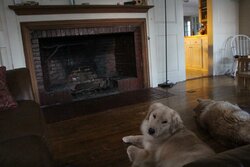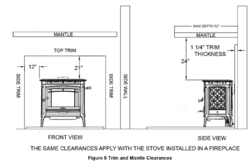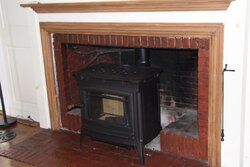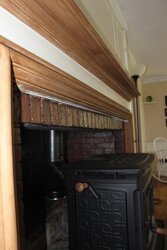Greetings Pyros,

I have spent the last few weeks reading up as much as I can in this great forum (thanks!).
After moving into our new 2500 sq ft home in mid-February and burning a 500 gallon tank of oil through the rest of the season I am looking to move to wood burning for cost savings and I really love the comfort of the heat.
The house is a 1930's ranch with ceiling height of 7 1/2 feet. It's an L shape with full basement. The windows are casement wood that swing in, single pane but new storm windows that were installed professionally.
We get to skip the "what should I buy" commentary as I have a new Hearthstone Manchester coming to the house.
Fireplace is at the middle of the L shape in living room. Bedrooms are farthest away at each end of L. The chimney is 25 feet tall (ground to top). I am putting in a flexible liner all the way up (of course). Chimney inspected, no cracks, up for the job. Chimney is 1/4 out of house and 3/4 within the framing of the house. You can see part of the chimney ground to top. It's on the north side of house. It has a clay lining approx 12"x12" after you get past the huge smoke chamber that is over the damper.
1. Should I expect any drafting issues?
2. Fireplace opening is 60" wide, 40" tall. I want to throw the Manchester all the way in it. I will need a serious blocker plate where the damper is. Can I squeeze flex liner in order to pass it through the damper (It's about 5"x 48". Otherwise I may need to do a round from stove to oval through damper and then back to round config up flu, is this doable as I don't want to rip apart damper and brick work?
3. If the stove sits in the fireplace completely can I put a small fan behind stove on ground? I don't want to buy the $400 one but don't want the heat sitting in fireplace cavity. Perhaps I should do the rear heat shield that is purpose built ($$$) or maybe just throw something back ($) there to reflect the heat. Thoughts?
4. Though the stove fits all the way in I probably need to do some shielding of the wood trim around fireplace that sit over stove?
5. I have a huge wood shed (3 cords capacity) , it's like a shed so it's not vented very well though but sits in the sun, should I just stack wood outside with tarp?
6. How close can I stack some indoor wood next to stove? Like right next to it or does it go by stove clearances?
If I hadn't read as much as I did I would have 500 questions! I can't really find a good thread on what is ideal for chimney height details to know about drafting issues.
BTW, all 3 chimneys (6 flus total) and caps and all plumbing vents on roof are all connected to metal spikes sitting atop roof and are grounded for lightning.
Thanks for any input

I have spent the last few weeks reading up as much as I can in this great forum (thanks!).
After moving into our new 2500 sq ft home in mid-February and burning a 500 gallon tank of oil through the rest of the season I am looking to move to wood burning for cost savings and I really love the comfort of the heat.
The house is a 1930's ranch with ceiling height of 7 1/2 feet. It's an L shape with full basement. The windows are casement wood that swing in, single pane but new storm windows that were installed professionally.
We get to skip the "what should I buy" commentary as I have a new Hearthstone Manchester coming to the house.
Fireplace is at the middle of the L shape in living room. Bedrooms are farthest away at each end of L. The chimney is 25 feet tall (ground to top). I am putting in a flexible liner all the way up (of course). Chimney inspected, no cracks, up for the job. Chimney is 1/4 out of house and 3/4 within the framing of the house. You can see part of the chimney ground to top. It's on the north side of house. It has a clay lining approx 12"x12" after you get past the huge smoke chamber that is over the damper.
1. Should I expect any drafting issues?
2. Fireplace opening is 60" wide, 40" tall. I want to throw the Manchester all the way in it. I will need a serious blocker plate where the damper is. Can I squeeze flex liner in order to pass it through the damper (It's about 5"x 48". Otherwise I may need to do a round from stove to oval through damper and then back to round config up flu, is this doable as I don't want to rip apart damper and brick work?
3. If the stove sits in the fireplace completely can I put a small fan behind stove on ground? I don't want to buy the $400 one but don't want the heat sitting in fireplace cavity. Perhaps I should do the rear heat shield that is purpose built ($$$) or maybe just throw something back ($) there to reflect the heat. Thoughts?
4. Though the stove fits all the way in I probably need to do some shielding of the wood trim around fireplace that sit over stove?
5. I have a huge wood shed (3 cords capacity) , it's like a shed so it's not vented very well though but sits in the sun, should I just stack wood outside with tarp?
6. How close can I stack some indoor wood next to stove? Like right next to it or does it go by stove clearances?
If I hadn't read as much as I did I would have 500 questions! I can't really find a good thread on what is ideal for chimney height details to know about drafting issues.
BTW, all 3 chimneys (6 flus total) and caps and all plumbing vents on roof are all connected to metal spikes sitting atop roof and are grounded for lightning.
Thanks for any input



 So if you rear exit and pull it out on the hearth, you will have an additional 90* turn which could moderate the draft a little, I don't know. Plus it may be a bit easier to reach the key damper if you install one, and like you said the side door will be more accessible. I like side loading myself... That's one gorgeous stove; I would want it out on the hearth a bit so I could see more of it!
So if you rear exit and pull it out on the hearth, you will have an additional 90* turn which could moderate the draft a little, I don't know. Plus it may be a bit easier to reach the key damper if you install one, and like you said the side door will be more accessible. I like side loading myself... That's one gorgeous stove; I would want it out on the hearth a bit so I could see more of it!  What color did you get? I know they had a couple minor issues with the first run of the Manchester, but they probably have those ironed out. I'll be looking for performance updates from you as the season progresses, as I have a couple friends with homes where I think this beauty would work nicely.
What color did you get? I know they had a couple minor issues with the first run of the Manchester, but they probably have those ironed out. I'll be looking for performance updates from you as the season progresses, as I have a couple friends with homes where I think this beauty would work nicely. 


